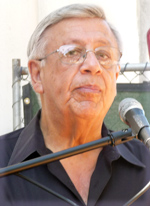By José Galicot

TIJUANA, Mexico — I was poor and didn’t realize it.
Our arrival in Tijuana, a city of twenty thousand inhabitants, was a significant moment in my life. It was August, a hot month that brought a plague of fleas due to the unpaved streets. We embarked on a train journey from Mexico City, where we unfortunately lost all our hard-earned money in Chihuahua. Despite this setback, we were ready to face the challenges ahead.
My father quickly threw some blankets over his shoulder that my grandfather had allowed him to sell, and in one day of hard work, he earned $100. He then took the money, went to Jai Alai games, and lost it. This incident, where we didn’t have enough to eat for the day, was a stark reminder of our financial situation and a lesson for my dad, Don Rafael: never gamble again.
My house was small and situated at the intersection of Second Street and Avenue F. In this downtown area, the most impoverished individuals, who had very little to eat, would come to sample my mother’s culinary experiments free of charge.
My mom was 15 years old when I was born and she, my brother Julio, and I grew up together. I went to Miguel F. Martinez school, which has always been a public school, where all of us children came from migrant families who came to Tijuana for opportunities. I remember the kid who enjoyed the best economy, Alfonso de la Torre, whose parents owned La Canasta Market. He had baseball gloves, bats, and baseballs, which made him famous and appreciated.
In my elementary school, there were teachers like Rendón, Rolón, Centeno, Quintero, and others of whom my memory is faint. I thought it was customary to live in a small house on the edge of the street and attend a school where practically all the students were of the same socioeconomic level and ate the lollipops sold to us after school. No one wore brand-name clothes (if any) at that time. No classmate could brag about having more than the others. The classrooms could accommodate 70 students, segregated into groups of girls and boys, and my father would reward me with one or two books every week, depending on my grades. Thus, I read books by Emilio Salgari, Jules Verne, Alexandre Dumas, and other adventure authors.
One day, Mr. Jack M. Sweed, owner of “Sweed Imports” on Avenida Revolucion, invited us to his house. It was a revelation. His home had a garden with swings and playground equipment that I had never seen or even dreamed I could have access to! It was the first time I realized that there were riches I didn’t know about, significantly altering my perception of wealth and poverty.
Due to a disagreement with a teacher, I left Miguel F. Martínez school in sixth grade and transferred to Lázaro Cárdenas, located on Avenue C. Interestingly, the cathedral, a bridal store, the school, the jail, and a union all came together on the same block, creating a peculiar folkloric scene within the small city.
At Lázaro Cárdenas, I studied with teacher Angelina Aros in a mixed group. It’s where I met the Chong brothers, my buddy Bracamontes, his sister Armida, and the legendary Professor Pompa. It was not unusual to see prisoners jumping from the jail facility to the schoolyard, attempting to escape from their imprisonment.
I had a profound realization during my high school years at the Sephardic Hebrew School in Mexico City. I was invited to spend a weekend at a friend’s house in Cuernavaca, and it was there that I truly understood the concept of wealth. Tomas had two houses, a weekend vacation home, abundant greenery, a swimming pool, and many more amenities. It was at that moment, at the age of 14, that I realized the extent of our financial struggles, but I never felt envious. It was a simple comparison that led to a profound understanding.
In high school, I was elected president of the student society. As a good student and one of the best athletes, I had several girlfriends and was popular, which made me admired by the rich and poor and prevented me from wanting something from others. With the 100 dollars that my father sent me monthly, I could pay my tuition, afford the student house where I lived, and even obtain tickets to the theaters that I loved because I was an admirer of Nadya de Haro Oliva, a beautiful French woman who did vaudeville and whose shows I never missed.
Looking back on those times, I realize I was always content. I was surrounded by friends, cared for by my parents, and was an avid reader. On my birthdays, I received clothes as gifts, and while I might have expected a toy or something else, I was always happy. It was a life of simple pleasures, and I never fully realized that we were struggling financially.
*
José Galicot is a leader of the Mexican Jewish communities in Tijuana and San Diego. He is the founding director of Tijuana Innovadora.
José Galicot is a leader of the Mexican Jewish communities in Tijuana and San Diego. He is the founding director of Tijuana Innovadora.
Thank you for sharing this! The great majority of stories we hear in the American Jewish communnity about Jewish Diaspora origins ooutside the USA are European. This opens my eyes, and I am sure they eyes of others, about the diversity of the Jewish Diaspora in the world. A piece such as this also gives us historical perspective. Again, thank you.
Cool but what’s the point of the article?